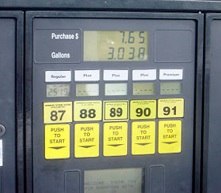In the unlikely event that you were wondering where we’ve been for the past few days I can tell you that we’ve been wondering about fuel economy and RON.
We have chosen an economical (by mpg) SUV, and one which has proper brakes and gears too, unlike the typical US versions, which look great but can only go in a straight line.
Like this for instance:

Anyway, great in a straight line, hopeless if you need to brake (it weights over 2.5 tonnes) or go around corners (less of a problem in the US thankfully). Also, its not so useful for carting children and their belongings around, unless they like to sit in the back in the open air (don’t ask them though).
The XC90 is designed to drive round the fjords so you know its good on corners and at least one reviewer thinks that "The brake pedal is rather touchy, but stopping distances are short." So that’s handy then.
So to fuel economy, which is interesting. If you look at the US and UK Volvo websites you get quite different numbers, as shown below:
Driving situation MPG (UK) MPG (US)
urban/city 16.4 11.7
extra urban/highway 30.7 16.7
These numbers have been adjusted to take account of the difference in US and UK gallons and US and UK miles.
With US gas prices at around $3.50 per (US) gallon at present, this means that it would cost an average of $0.22 per mile to drive the US version but only $0.14 per mile to drive the UK version (taking into account the differences mentioned above).
However, if we had the UK XC90 in the UK it would cost an average of $0.44 per mile to drive, given the higher price of gas there. Which is nice. This is where RON comes in. RON is the Research Octane Number of fuel, a measure of knock (caused when fuel ignites when it shouldn’t) resistance. In the US, fuel is available from 87 to 91 (or 93 sometimes) RON, with the latter being called “Super”, “Premium” or similar. In the UK, the lowest standard available is 95 RON and the highest 97 (or 99 sometimes). I doubt that the technology to produce higher octane fuel is not yet available in the US so I can only assume that they are saving this improvement for some future time (hopefully before oil runs out for good).
This is where RON comes in. RON is the Research Octane Number of fuel, a measure of knock (caused when fuel ignites when it shouldn’t) resistance. In the US, fuel is available from 87 to 91 (or 93 sometimes) RON, with the latter being called “Super”, “Premium” or similar. In the UK, the lowest standard available is 95 RON and the highest 97 (or 99 sometimes). I doubt that the technology to produce higher octane fuel is not yet available in the US so I can only assume that they are saving this improvement for some future time (hopefully before oil runs out for good).
Now to work out the effect of a lower octane rating on fuel economy and the price per mile...

